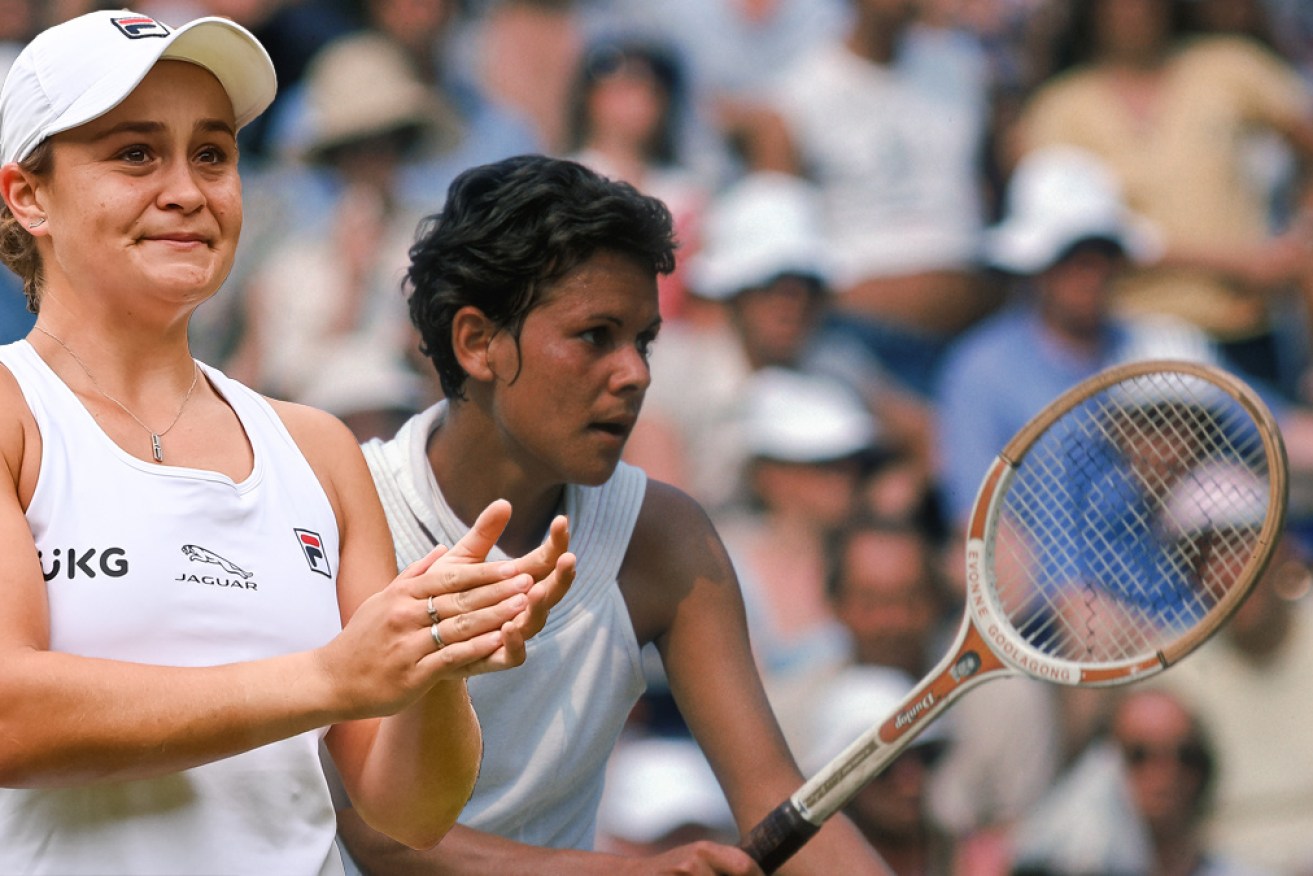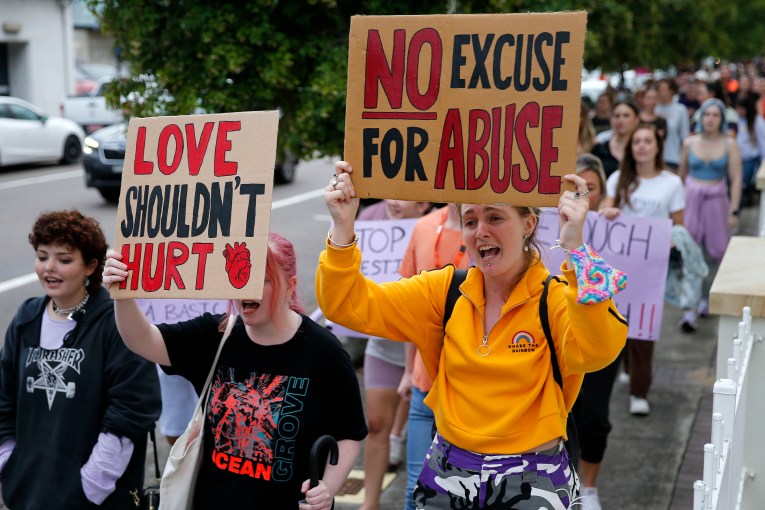Ash Barty secures her spot in history alongside Evonne Goolagong Cawley


Our Wimbledon women – Ash Barty and Evonne Goolagong Cawley. Photo: Getty/TND
There was a time before Roger Federer’s emergence as arguably the most exquisitely skilled player of his – perhaps any – generation that another tennis aesthete, Evonne Goolagong Cawley, did not watch tennis.
Then, while becoming entranced by the Swiss master’s sublime variety, elegance and style, the dual Wimbledon champion recalls thinking how nice it would be if a young woman came along who possessed a little of the Federer magic.
Just over a decade ago at Melbourne Park, there she was; an Indigenous girl named Ashleigh Barty playing in the Australian Open juniors who not only had every shot, but could play them all in the same point.
“I knew from the first moment I saw her when she was 13 that she was going to be a champion. She had everything, and that can only help players of the future,’’ said Goolagong Cawley, describing Barty as a superb role model who would inspire a generation – and not just through what she does, and how, on the court, but also by the way she handles herself off it.
Each of those facets was showcased on Saturday night, when Barty added a prestigious second major to her 2019 French Open title by becoming Australia’s first Wimbledon women’s singles champion since Goolagong Cawley claimed her second title in 1980.
Meanwhile, back in their shared home state of Queensland, the beloved Aboriginal trailblazer, now 69, found herself hugging her chair, dancing and crying all at once.
“I hope I made Evonne proud,’’ an emotional Barty said on the All England Club’s Centre Court after a three-set defeat of Czech eighth seed Karolina Pliskova, as a nation collectively teared up in lounge rooms across the land.
Proud? Tick. As if there was ever any doubt.
Other questions were answered, too, during a fortnight Barty entered without having played since being forced to retire in the second round at Roland Garros with a left hip injury that would normally take two months to heal.
It was “nothing short of a miracle,’’ she admitted, that could play at all, but especially pain free.
Then there was the surface. While the likes of Paul McNamee and Alicia Molik have long considered clay to be her best, it is on grass that Barty has always felt most comfortable, with Wimbledon the title she has only recently admitted publicly that she most coveted.
“I think once you start verbalising it, then things happen. Dreams do come true, and that’s one of the last messages I sent her: Dreams do come true,’’ Goolagong said, admitting to be chuffed that Barty wore a tribute outfit modelled on two of her old dresses, as part of the stars aligning in a multiple of ways.

Evonne Goolagong Cawley and Ash Barty at the 2019 Newcombe Medal Night, which Barty took home that night. Photo: Getty
Earlier this year, after a quarter-final exit at the Australian Open while battling a thigh injury, there had been mutterings about whether she was a deserving world No.1, Barty having stayed home in Ipswich for most of a COVID-contaminated 2021, and gone 23 months between grand slam titles.
Not only has her stint at the top now lasted 84 weeks, Barty has opened up a 1843-point break over second-placed Roland Garros winner Barbora Krejcikova in the calendar year Race to Shenzhen. Hard to argue with that.
Indeed, the wrong turn Barty took on the way up to greet her team, Pat Cash style, in the stand after her momentous victory was a rare loss of direction.
The admirable young woman who values being a good person over being a good tennis player always seems to find the appropriate words; rarely makes a false step.
But this time, as she clambered on to the roof of the broadcast box, she was unaware initially that the All England Club has provided a more direct path to the players’ box in the years since Cash and others climbed on up. “I probably just should have taken the elegant route, but that’s OK,” Barty laughed.
In various ways, her history at the world’s most famous tournament has mirrored her personal story: As the junior prodigy who won the girls’ title in 2011, then the player who returned with new-found perspective after her teen sabbatical to lose in qualifying during the early stages of her comeback in 2016, and who the next year as the 17th seed suffered such a disappointing third-round loss to Daria Kasatkina that it prompted a major reassessment that would lead her to renowned mindset coach Ben Crowe.
She has flourished ever since. Indeed, since 2017, when Barty made her Tour-level breakthrough at the Malaysian Open, the WTA notes that her 12 titles are the most of any woman, she sits second behind only Serena Williams for winning match percentage (76.2 per cent), and has the highest ratio of finals reached per tournament played (28.1 per cent).
Her next major assignments will be on the hard courts dominated of late by four-time major winner Naomi Osaka, with the Tokyo Olympics’ tennis event starting in 12 days and a US Open showdown to follow from August 30.
But such is the evolving state of the women’s game that more opportunities beckon.
With Williams surely in her farewell season, Simona Halep missing the past two majors and Osaka dealing with mental health issues, there have been 16 different players in the semi-finals of the past four slams.

Ash Barty’s name will be etched in history on the Venus Rosewater Dish. Photo: Getty
As for why it has taken so long for an Australian to cuddle the famous Venus Rosewater Dish, then, from a national perspective at least, Cash (1987) and Lleyton Hewitt (2002) have been more recent All England Club champions.
In contrast, the women’s standout of the past two decades, 2011 US Open champion Sam Stosur, was never at her best on grass, with Molik and 2000 semi-finalist Jelena Dokic the only others to feature in the WTA top 10 this century before Barty’s temporarily interrupted ascent.
It is an enduring misnomer that this supremely talented sportswoman took a 17-month break from tennis to play cricket.
In fact, she played cricket – and golf, and coached – during part of that 17-month break from tennis, but that was never why she walked away.
As her great mate and former doubles partner Casey Dellacqua said on Nine “Ash just was not in a good place”, and needed that 2014-15 hiatus in order to get to where she is today.
Which, marvellously, is on the Wimbledon honour board as the 2021 champion, the humble Ipswich native having reinforced her top-ranked status, while demonstrating her prowess as an all-court player of rare skill, poise and determination.
If her 2019 Roland Garros title was something of a surprise, this treasured All England Club crown came both as validation and the culmination of a life-long dream.
Goolagong Cawley speaks often of first learning of this magical Wimbledon Centre Court in the pages of Princess magazine; Barty is more tomboy than princess, but now tennis royalty all the same.
“She is the queen, now,’’ an emotional Dellacqua said.
While a national consensus is a rare thing indeed these days, then as Australians all rejoice, let us also agree: Ash Barty, long may she rule.








